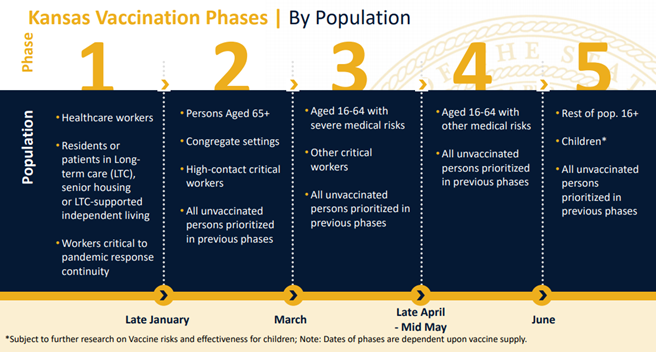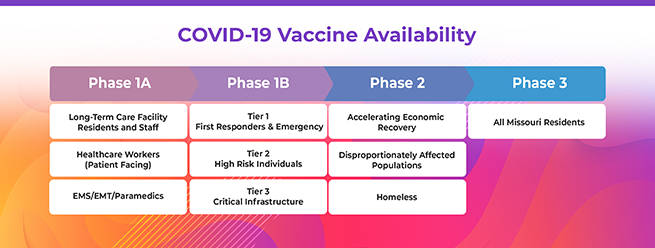(updated April 2, 2021)
Vaccination guidance for the construction industry in Missouri and Kansas
At the beginning of the pandemic, the construction industry was deemed an essential workforce, and work continued throughout 2020. With the COVID-19 vaccine now available, there’s confusion about where, exactly, the construction industry fits into the vaccination schedule. This bulletin seeks to answer your questions and provide some clarity on the matter.
Kansas
Governor Laura Kelly and her staff unveiled their COVID-19 Vaccination Prioritization Plan in January. It includes a chart of the five vaccination phases the state will be following to prioritize shots. The chart is shown below.

The construction industry is placed in Phase 3. This phase’s description states:
Non-healthcare workers in critical infrastructure, who cannot perform their duties remotely and therefore face risks of work-related exposure to COVID-19. Critical workers are characterized as those operating in-person to maintain systems, assets and activities that are vital to the state (or the country's) security, economy or public health, as defined by the Department of Homeland Security.
Examples of groups included are:
- Agricultural and food workers not included in previous phases.
- Workers performing in-person activities indoors, in critical manufacturing, not included in previous phases; this includes aviation, production of critical supplies for the COVID response.
- Utility workers.
- Social service and government workers not included in previous priority phases.
- Logistics workers, such as truck transportation workers, couriers and others.
- Water and wastewater workers.
- Shelter and housing (e.g., construction) workers, finance (e.g., bank tellers).
- Information technology and communications workers.
Kansas is currently in Phase 2. Monday, March 29, all Kansans aged 16 and over will be eligible for the COVID-19 vaccine.
Availability of the vaccine is highly dependent on supplies states receive from the federal government. Kansas has created a COVID-19 response website that includes information like free testing locations, state data on cases, recovery resources for businesses and more.
Missouri
Governor Mike Parson and his staff created the Show Me Strong Recovery Plan that provides guidelines, data and resources for citizens, businesses and communities during this pandemic. This was followed up with a comprehensive vaccine website and the unveiling of a Missouri COVID-19 vaccination phased plan. See the information below. For up-to-date data on the COVID-19 virus in Missouri click here.

COVID-19 vaccine availability
Phase 1A - Patient-Facing Health Care Workers and Long-Term Care Facility Residents and Staff
Vaccinating those most vulnerable and those protecting them.
- Hospitals, long-term care facilities and residents, including Department of Mental Health (DMH)-operated facilities.
- Home health, hospice, dialysis centers, urgent care.
- Vaccinator staff and those administering COVID testing.
- Congregate community healthcare settings staff and residents, including DMH contracted settings and adult day cares..
- EMS and high-risk non-congregate healthcare, including clinics, physicians, and home care providers.
- All remaining patient-facing healthcare providers, including but not limited to health care workers in emergency shelters, dental offices, school nurses, pharmacies, public health clinics, mental/behavioral health providers and correctional settings.
- Clergy who minister to those in long-term care/congregate facilities or hospitals.
- Unpaid healthcare workers, including family caregivers, providing in-home care to those who are unable to care for themselves and who are at an increased risk for sever illness as a result of COVID-19.
Phase 1B – Tier 1: First Responders, Emergency Services, and Public Health Infrastructure Protecting those who keep us safe and help us during an emergency
Protecting those who keep us safe and help us during an emergency.
- Non-Patient Facing Public Health Infrastructure*: Administrators and staff at federal, state, or local public health agencies and other healthcare workers who carry out functions necessary to the operation of the state’s healthcare infrastructure that were not included in 1A.
- First Responders*: All federal, state, and/or local first responders beyond EMS/EMTs in 1A, including law enforcement, fire services, corrections, and certain social service agencies.
- Emergency Management and Public Works*: Federal, state, or local government employees in emergency management and public works agencies, identified nonprofit organizations designated as partner voluntary agencies.
- Emergency Services Sector: Employees defined in the emergency services sector not otherwise listed, including law enforcement, fire and rescue services, emergency medical services, emergency management, and public works.
Phase 1B – Tier 2: High-Risk Individuals
Protecting those who are at increased risk for severe illness.
- Anyone 65 and older
- Any adults with cancer, chronic kidney disease, COPD, heart conditions, weakened immune system due to organ transplant, severe obesity (BMI >40), pregnancy, sickle cell disease, Type 2 diabetes mellitus, or individuals with intellectual and/or developmental disabilities such as Down Syndrome.
Phase 1B – Tier 3: Critical Infrastructure
Protecting those who keep the essential functions of society running.
- Education
- Child care
- Communications infrastructure
- Dams sector
- Energy sector
- Food & agriculture sector– initial*: Employees of certain food production and processing
facilities, and related operations, prioritizing mass food production, distribution, transportation,
wholesale and retail sales, including grocery and convenience stores where groceries are sold;
includes veterinary services
- Government
- Information technology sector
- Nuclear reactor sector
- Transportation systems
- Water and wastewater systems
Phase 2: Equity & Economic Recovery
Accelerating equitable economic growth.
- Chemical sector
- Construction sector
- Commercial facilities sector
- Critical manufacturing sector
- Defense industrial base sector
- Financial services sector
- Food & agriculture sector – remaining*: Remaining populations within the sector not included in 1B, including restaurants.
- Government
- Higher education
- Disproportionately affected
- Homeless
Phase 3
The director of the Missouri Department of Health & Senior Services has added the construction industry under Phase 2: Equity and Economic Recovery.
State officials stated that individuals are asked to self-attest to their eligibility in the priority phases based on the definitions provided for age, medical conditions and employer type. The state will not provide, and is not asking vaccinators to require, documentation of eligibility beyond that attestation. Workers who fall into an earlier priority phase, such as Phase 1B – Tier 2, for certain high-risk conditions, are eligible to receive the vaccine when that phase is activated, regardless of an employers’ priority phase.
As of Monday, March 29, Missouri is under Phase 2. Phase 3, which includes all adults in Missouri, commences on Friday, April 9.
If you have further questions, please reach out to Allen Dillingham, government relations director for The Builders’ Association at [email protected] or 816-595-4121.